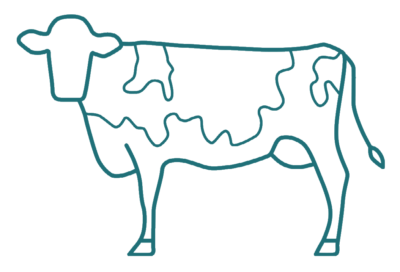Proper nutrition plays a pivotal role in the health, productivity, and well-being of dairy cows.
Nutrition plays a crucial role in milk production. Cows require a precise balance of carbohydrates, proteins, fats, vitamins, and minerals to produce milk efficiently. A typical cow in Washington eats about 75 to 100 lbs. of food and drinks around 35 gallons of water daily.
Farmers work with specialized nutritionists and veterinarians to create nutrition programs that ensure cows receive adequate energy to support milk production and maintain their well-being. By optimizing nutrition, dairy farmers can achieve higher milk yields and improve the composition of milk.
Plus, proper nutrition is essential for cow health. A balanced diet supports a robust immune system, reducing the risk of diseases and infections. It promotes healthy rumen function, minimizing digestive disorders and metabolic issues. Nutritional strategies that prioritize cow health also contribute to reduced veterinary costs and overall improved animal welfare.

In addition to the critical role of nutrition in cow health, cows themselves play a remarkable role as upcyclers! They possess the unique ability to digest complex fibrous foods that humans cannot. For example, a significant portion of a cow’s diet in Washington consists of by-products derived from human food production processes, such as brewers’ grains or bakers’ waste.
These by-products, which would otherwise go to waste, are effectively upcycled into nutrient-rich feed for cows. In fact, each day cows in Washington eat more than 5.4 million lbs. of local by-products that would otherwise end up in landfills. Cows contribute to a sustainable and circular food system by then converting these by-products into valuable milk and other dairy products.
In total, 45% to 55% of a cow’s diet consists of by-products mostly derived from human food production processes. Common by-products that are fed to cows include (but are not limited to):
| Sugar Beet Pulp | Cotton seeds | Sweet corn residue |
| Soybean and Canola meals | Linseed and sunflower meals | Corn distiller’s grain |
| Almond Hulls | Rice Bran and Hulls | Culled potatoes and apples |
The other source of cows’ diet, forage, consists of grass or alfalfa silage or hay, as well as whole corn plants. Together, these dry matter components make up about 40% of a cow’s diet. An additional 5% to 15% of the diet consists of corn or barley grain to accelerate fiber digestion.
Washington’s dairy farmers understand the vital connection between nutrition, cow health, and sustainable practices. By employing advanced nutritional practices, working closely with experts, and embracing their role as upcyclers, they ensure their cows receive the best nutrition, leading to exceptional milk production, cow happiness, and a thriving dairy industry.
